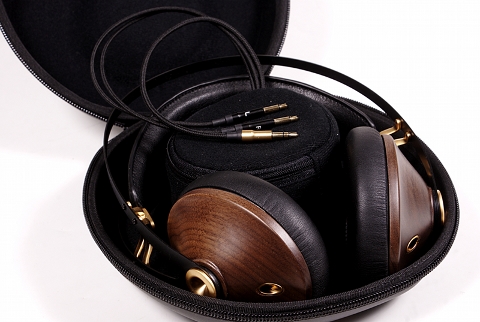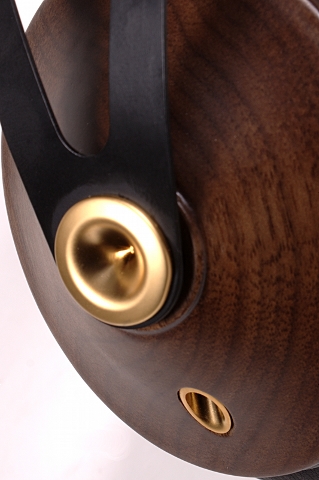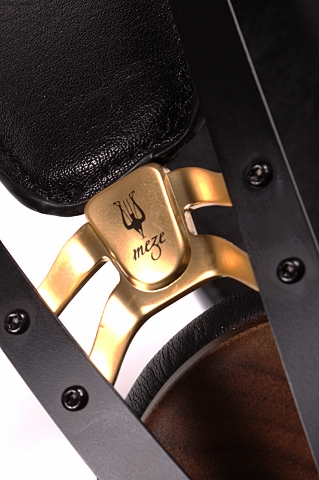about Audio, High Fidelity
& Home Entertainment technologies
pid: 607-2025/10/01 (v1.2)
Privacy Policy

Listening evaluation of the 99 Classics was done in two phases, to cover both possible user profiles. During the first phase, the headphones were used in conjunction with the Questyle QP1R, a top-class portable media player, on which you can read a review here. During the second phase (which was the longer in duration) the headphones were connected to the reference system, in our usual listening tests environment. In this case, a Benchmark DAC2 HGC was to drive the headphones (you can read a review in Greek language here. Also, quite briefly, the internal Melos Plus Series Line headphone amp was used, however, this configuration served more for breaking-in purposes and less during listening sessions. In every case, Grado RS2 were used as the reference headphones.
For starters, Meze's 99 Classics made a quite good impression, starting from their packing material. The headphones are delivered in a hard carrying case which can be used to protect them both at home and during commuting and includes a special pouch for the accessories and the second cable. Fitting of the headphones was good. The ear cup/pad diameter is rather moderate for an over-ear design, and perhaps -for some users- the pads are in touch with the pinna (the outer ear) a little more than one would expect. Nevertheless, the noise isolation offered is very good both for use in the domestic environment (where the requirements for external noise suppression are, obviously, more relaxed) and for use outside, where, in combination with their closed architecture, the headphones offer a good listening environment. This is important because a good isolation feeling leads usually to listening to lower-levels, therefore to a smaller probability to cause hearing loss and damage, an issue that is important, especially between regular headphone users. To their credit, Meze includes -in the user's manual- a standard chart which associates listening levels and maximum listening time allowance, before permanent damage occurs, an always useful info. The very good isolation 99 Classics offer, highlights a side-problem -one not unusual for over-ear/closed systems- the mechanically induced cable noise. When the user is in motion, the friction of the cable to the clothes creates some kind of noise which is known as cable microphonics. In this particular case, noise is perceivable only during very low-level music passages or music pauses and cannot be considered a serious problem, however, it is present in some situations. In the home listening environment, where the user rarely moves enough, the problem is even smaller, probably unimportant. A noise of similar nature, due to resonance, originates from the metal frame, but to occur, someone has to excite the frame deliberately, a rather unusual behavior, indeed, except perhaps for reviewing purposes!
During normal use, now, the 99 Classics proved particularly attractive in terms of their sonic character and the results showed that Meze has made a good choice in terms of the voicing they opted for.
The low-frequency range was characterized by a very good feeling of presence, power, and detail description. Depending on the music material, the result could be imposing without being oppressive or out of balance. Compared to the reference headphones, the very low-frequency part of the audio spectrum is certainly more intense and the feeling is that the sound is more full, an attribute which a lot of listeners will appreciate. Rhythm section appears with clarity, slightly balanced towards an emphatic character with good speed. The 99 Classics seemed to have a strong capacity to process the program microdynamics and certainly will never tire the listener, even during quite lengthy listening sessions at relatively high levels. Musical instruments with heavy low-frequency content were reproduced in high detail and a good feeling of scale. Nevertheless, there is a slight highlighting trend here, which is quite pleasant while the headphones never showed any lack of homogeneity or a tendency to color the total result.
Mid frequency band has great presence, appears to be detailed and pleasantly bright, while the listener is faced with a slight laid back character. There are indications that Meze has made a balancing act between a completely easy-to-the ear, program flattering presentation and an absolutely precise monitor-like description, giving the listener a rather restful and airier performance but with no lack of any important details. As I see it, this choice is quite successful, as it provides accurate and pleasant sound, even if a particular recording (or file encoding for that matter) is not of top quality -and all listeners, inevitably, will encounter such a program. In this context, the human voice, both in solo and choir recordings, is well presented, with accurate timbre description, good feeling of scale and clear definition and focus.
The upper part of the spectrum offers the feeling of good extension and air, slightly trending towards a soft and quite engaging character, being consistent with the mid-frequency behavior and the overall feeling that 99 Classics offer. Compared to our reference, 99 Classics seem somewhat slower during the attack part (in percussive instruments) but with good decay/sustain and release times giving a comfortable impression of clarity and good harmonics. Overall impression in high frequency-rich program is somewhat towards the dark side, an approach I think is both enjoyable and interesting to listen to.
Stereo imaging evaluation with headphones is always a tricky case. Using conventional stereo recordings, the 99 Classics showed a very good ability to precisely focus the different audio objects in a mix, along the horizontal axis, with good separation and air between them, and, also, proved quite good in motion description. Although closed, they are not particularly oppressive and even large sized orchestras sounded friendly and satisfactory (despite the known and inevitable feeling that everything has been moved between your ears). Using binaural recordings (optimized for headphones), on the other hand, 99 Classics showed a quite wide headroom for even better performance, being able to construct a complex sound field with a sense of depth and sound source motion and proved highly capable in reproduction of acoustic spaces into which the listener is immersed (soundscaping).
Conclusion
The elegant design and the high construction quality of the 99 Classics are consistent with an equally meticulously, wisely one might say, chosen sonic behavior. Meze seems to know the game well and created a quite remarkable product at an attractive price. The 99 Classics proved to be equally suited both for on-the-go and home use, offering good noise isolation and an enjoyable and accurate sound character. They are targeted at those audiophiles that are looking for a versatile headphone and, indeed, they constitute a very good choice!
Previous | Next | More Reviews



